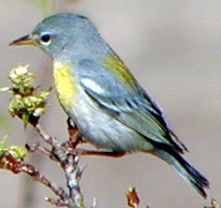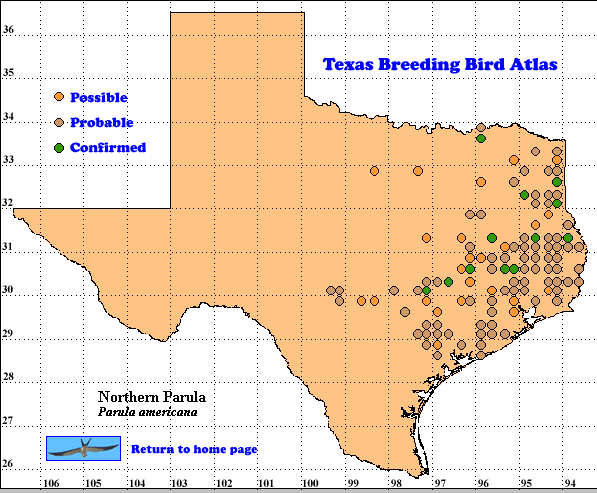Northern Parula, a warbler, is a relatively widespread species in eastern North America. Two populations have been identified by differences in vocalizations, one east of a line from Ontario to Alabama and the other west, including Texas. While it is tempting to speculate that the western population migrates through Texas to winter in Mexico and northern Central America while the eastern race winters in the Caribbean, no data is available to confirm or deny this hypothesis. Extensive further study is needed to define the degree of difference between these two groups. Future study is also needed of many aspects of the life history of this species. Much of the breeding behavior is unknown, partly because of the pseudo-cavity nature of the nest (Moldenhauer and Regelski 1996).
DISTRIBUTION: During the 1987-1992 field work of the TBBA project, atlasers found the thickest concentration of breeding records in the southern Pineywoods and southern Post Oak Savannah and Blackland Prairies regions and the northern Coastal Prairies with densities decreasing to the north, west and south (see the region map in Lockwood and Freeman [2004]). The 135 probable records were the most common level of breeding evidence, outnumbering the 38 possible and 15 confirmed records. The range extends at least as far south as San Patricio County where Skoruppa and Blacklock (2007) found territorial males along the lower Nueces River in 2005.
The overall breeding range of the Northern Parula extends from eastern Manitoba to the Maritime Provinces of Canada and south to the Gulf Coast states. A gap in this range extending from the Great Lakes states to New England is apparently due to habitat changes that eliminated the hanging epiphytes used by this warbler for its nest sites. Northern Parula winters along the Gulf Coast from south Tamaulipas, Mexico to Honduras, the Pacific Coast of Oaxaca and Chiapas, Mexico, the Florida Keys and most of the West Indies, the Bahamas and Bermuda. The species wanders widely outside its normal ranges; it has breed on the California coast (Moldenhauer and Regelski 1996, Sauer et al. 2005).
SEASONAL OCCURRENCE. These warblers arrive in Texas between February 21 and May 28 with peak numbers from mid-March to mid-May. Breeding occurs from early April to mid-July, suggested by egg dates from April 20 to May 30. TBBA atlasers found a bird on a nest on April 2 and parents feeding recently ;fledged young on June 30. Southbound migration takes place between June 30 and November 23 with most movement from mid-August to late October (Oberholser 1974, Lockwood and Freeman 2004).
BREEDING HABITAT. Northern Parulas breed in Texas from near sea level to 550 m (1800 ft) in deciduous or coniferous woodlands near water. Nests are placed in Spanish moss or similar strands of gray-green lichen (Oberholser 1974). In Oklahoma this warbler prefers riparian areas or bottomland forest near swamps especially where Spanish moss is available (Kuhnert 2004). Nests are built in Spanish moss or other similar hanging epiphytes. Most work is done by the female who either excavates a cup in the bottom of a hollow in the hanging mass using a side entrance or uses strands to form a curtain around the nest. A nest can vary widely in height above the ground and in materials used. Nests may be built or lined with strands of the epiphyte, the cup may be built of grass, plant stems or roots and lined with hair, fine grasses and plant down. The outside diameter of the nest is usually 6-7 cm (2.4-2.8 in) and inside diameter is 4.8 cm (1.9 in; Harrison 1979, Moldenhauer and Regelski 1996).
In the cup, the female usually lays 4 (range 2-7) smooth, white eggs, variably speckled and spotted with brown to red or purple markings, often mostly at the large end. These are incubated by the female alone for 12-14 days and the young usually leave the nest 10-11 days after hatching. (Moldenhauer and Regelski 1996).
STATUS. The distribution of summer and breeding locations on the map in Oberholser (1974) is generally similar to the TBBA map below. Lockwood and Freeman (2004) characterize Northern Parula as an uncommon to common summer resident in east Texas. The North American Breeding Bird Survey (BBS) reports a maximum relative abundance of 1-3 Northern Parulas detected per 40 km (25 mi) route and data from 26 routes in Texas suggest a population change of about -1.0% for the period 1980-2005. This relatively small change is similar to the suggested +0.3% derived from 886 routes spread across the Eastern BBS region (Sauer et al. 2005). While neither of these trend estimates is statistically significant, they suggest any population change in Texas and the eastern United States and Canada over the last quarter century has been small. Text by Robert C. Tweit (2007)
Lockwood, M. W. and B. Freeman. 2004. The TOS handbook of Texas birds. Texas A&M University Press, College Station.
Oberholser, H. C. 1974. The bird life of Texas, University of Texas Press, Austin.
Skoruppa, M. K. and G. W. Blacklock. 2007. Three noteworthy species of woodland birds in a riparian forest of the lower Nueces River, San Patricio County, Texas. Bull. Texas Ornith. Soc. 40: 11-17.

